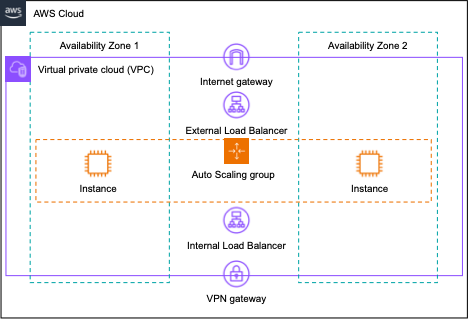
Multiple Load Balancer Support in AWS CodeDeploy
October 20, 2023AWS CodeDeploy is a fully managed deployment service that automates software deployments to various compute services, such as Amazon Elastic Compute Cloud (Amazon EC2), Amazon Elastic Container Service (ECS), AWS Lambda, and on-premises servers. AWS CodeDeploy recently announced support for deploying to applications that use multiple AWS Elastic Load Balancers (ELB). CodeDeploy now supports multiple Classic Load Balancers (CLB), and multiple target groups associated with Application Load Balancers (ALB) or Network Load Balancer (NLB) when using CodeDeploy with Amazon EC2. In this blog post, I will show you how to deploy an application served by multiple load balancers.
Background
AWS CodeDeploy simplifies deploying application updates across Amazon EC2 instances registered with Elastic Load Balancers. The integration provides an automated, scalable way to deploy updates without affecting application availability.
To use CodeDeploy with load balancers, you install the CodeDeploy agent on Amazon EC2 instances that have been registered as targets of a Classic, Application, or Network Load Balancer. When creating a CodeDeploy deployment group, you specify the load balancer and target groups you want to deploy updates to.
During deployment, CodeDeploy safely shifts traffic by deregistering instances from the load balancer, deploying the new application revision, and then re-registering the instances to route traffic back. This approach ensures application capacity and availability are maintained throughout the deployment process. CodeDeploy coordinates the traffic shift across groups of instances, so that the deployment rolls out in a controlled fashion.
CodeDeploy offers two deployment approaches to choose from based on your needs: in-place deployments and blue/green deployments. With in-place deployments, traffic is shifted to the new application revision on the same set of instances. This allows performing rapid, incremental updates. Blue/green deployments involve shifting traffic to a separate fleet of instances running the new revision. This approach enables easy rollback if needed. CodeDeploy makes it easy to automate either deployment strategy across your infrastructure.
Architectures with Multiple Load Balancers
CodeDeploy’s expanded integration with Elastic Load Balancing unlocks new deployment flexibility. Users can now register multiple Classic Load Balancers and multiple target groups associated with Application or Network Load Balancers. This allows you to deploy updates across complex applications that leverage multiple target groups. For example, many customers run applications that serve both an internal audience and external audience. Often, these two audiences require different authentication and security requirements. It is common to provide access to the internal and external audiences through different load balancers, as shown in the following image.

In the past, CodeDeploy only supported one load balancer per application. Customers running internal and external application tiers would have to duplicate environments, using separate EC2 instances and Amazon EC2 Auto Scaling groups for each audience. This resulted in overprovisioning and added overhead to manage duplicate resources.
With multiple load balancer support, CodeDeploy removes the need to duplicate environments. Users can now deploy updates to a single environment, and CodeDeploy will manage the deployment across both the internal and external load balancers. You simply select all the target groups used by your application, as shown in the following image.

This consolidated approach reduces infrastructure costs and operational complexity when automating deployments. CodeDeploy orchestrates the in-place or blue/green deployment across multiple load balanced target groups.
Migrating from a Classic Load Balancer
Many customers are migrating from Classic Load Balancers (CLB) to Application Load Balancers (ALB) or Network Load Balancers (NLB). ALB and NLB offer a more modern and advanced feature set than CLB, including integrated path-based and host-based routing, and native IPv6 support. They also deliver improved load balancing performance with higher throughput and lower latency. Other benefits include native integrations with AWS WAF, Shield, and Global Accelerator along with potential cost savings from requiring fewer load balancers. Overall, migrating to ALB or NLB provides an opportunity to gain advanced capabilities, better performance, tighter service integration, and reduced costs.
CodeDeploy’s new multi-target group capabilities streamline migrating from Classic Load Balancers (CLB) to Application or Network Load Balancers (ALB or NLB). Users can now deploy applications utilizing both legacy CLB and modern ALB or NLB in parallel during the transition. This enables gracefully testing integration with the new load balancers before fully cutting over. Once you verify that users have stopped using the CLB endpoint, you can delete the CLB.
During the transition period, CodeDeploy orchestrates deployments across the CLB and target groups tied to the ALB or NLB within a single automation. Users simply select the CLB and target groups of the new load balancer in the deployment group as shown in the following image.

This consolidated approach lets CodeDeploy coordinate a staged rollout across CLB and ALB/NLB. With simplified management of multiple load balancers, CodeDeploy eases the critical process of modernizing infrastructure while maintaining application availability.
Conclusion
CodeDeploy’s expanded integration with Elastic Load Balancing allows more flexible application deployments. Support for multiple Classic Load Balancers and multiple target groups associated with Application or Network Load Balancers enables you to seamlessly update complex architectures on AWS. Whether you are consolidating disparate environments or migrating from Classic Load Balancers, CodeDeploy simplifies managing deployments across multiple load balanced tiers. To learn more, see Integrating CodeDeploy with Elastic Load Balancing in the AWS CodeDeploy Developer Guide or visit the CodeDeploy product page.
